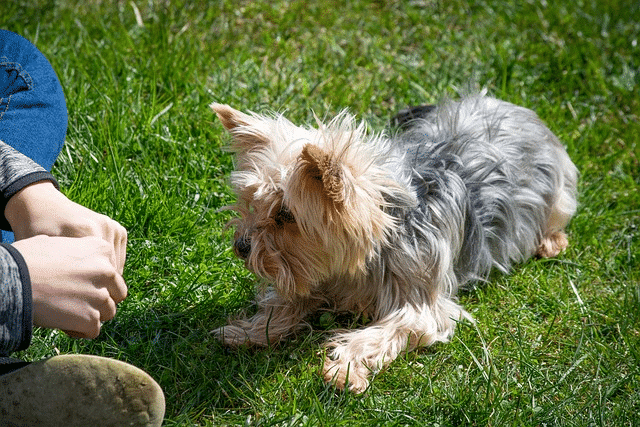Training your dog is an important aspect of owning a pet. However, the number of daily training sessions you do and how frequently you do them can be confusing. There are many different ideas on how often you should train your dog, however the answer may vary depending on your dog’s age and temperament. Continue reading to find out how often you should train your dog and what factors to consider.

Training Session
Dogs must be properly trained in order to work effectively. This includes teaching them basic instructions like sit, stay, come, and down. To keep your dog’s attention span and interest in learning new things, training sessions should be short, simple, and consistent. Training sessions, on the other hand, are normally held once a week.
Begin with simple commands that your dog is likely to know or can quickly learn. As your dog becomes good at simple commands, you can go to more complex ones. When your dog does something correctly, make sure to generously praise them; this will encourage them to keep learning.
Dog Training Sessions
Training your dog can be a fun and rewarding experience for both of you. You can help your dog create a strong bond and build the foundation for a lifetime of friendship by teaching him basic obedience commands. Training sessions should start off short, regular, and enjoyable.
Dogs learn best through reinforcement, so rewarding your pet for excellent behavior is important. The key to teaching your dog to sit, stay, or come when called is to be patient and have fun. You can train your dog to be a good companion with a little time and effort.
Dog Training
When discussing dog training, you might hear dog trainers refer to dog training sessions. This can be confusing if you’re not exactly sure how to conduct a dog training session. Understanding what makes a proper training session is an essential part of training your dog and will help you learn how to maximize your time and make your session the most effective it can be.
One Training Session
Set up regular training sessions with your dog to help them learn and remember the commands you’re teaching them. Start with short sessions and gradually increase the length of time as your dog gets better at following commands.
It’s important to be consistent with training sessions so your dog doesn’t get confused. Choose a time that works for you and stick to it.
How often should I train my dog?
Dogs are intelligent creatures who thrive on routines and structure. While each dog is unique, most experts believe that basic obedience training should be part of every dog’s daily routine. This may require several short sessions throughout the day for small dogs. You can extend each session as they get older and more familiar with the basic commands.
One or two longer training sessions each day are usually necessary for adult dogs. Of course, your dog’s specific needs may vary, so working with a professional trainer to develop a customized strategy is crucial. You may help your furry companion become a well-trained companion with a little patience and consistency.
About Session Training
A training session is a short period of time you set aside on random days to work on specific dog training commands, cues, actions, or behaviors. Most sessions are organized around a lesson or objective and a specific amount of time allotted to that goal. Training sessions can be used at any time during your dog’s life, but they are especially important when beginning obedience training. Dog training sessions can be used to introduce and reinforce basic commands and other behaviors.
Training sessions should be seen as an obligation. Change, cancel, or shorten the time unless absolutely necessary.
Start with little distractions
Make sure your dog has a positive training environment. This means starting with few to no distractions and gradually adding more as your dog becomes more comfortable. Start teaching your dog to sit, for example, in a quiet room with no other people or animals nearby. Once your dog has mastered the command in this low-distraction area, you can introduce more distractions, such as other humans or animals.
Focus
Dogs also have a short attention span and are easily distracted by their surroundings. As a result, it is important to focus your dog’s attention when teaching them something new. One way is to use treats or toys to encourage good behavior. You may also try teaching your dog in fifteen-minute intervals to keep their attention focused.
Duration
There is no such thing as a one-size-fits-all solution when it comes to training. The frequency and duration of your sessions will be determined by several factors, including your dog’s age, attention span, energy level, and learning ability. Having said that, most experts agree that basic training should be a part of any dog’s daily routine.
End with a positive note
As with any activity, it is important to end on a positive note. This will help your dog associate training with positive experiences, making him or her more likely to cooperate in the future. Make sure to give your dog plenty of treats or rewards for their efforts. And if you find yourself losing patience, take a break and try again later. You’ll be able to successfully train your dog in no time with a little patience.
Remember that every dog is unique, so adjust your training approach to your dog’s specific needs. This will set them up for success and provide a great experience for both of you.
How to train your dog in sessions?
Because dogs learn best through reinforcement, it is important to reward your dog for good behavior.
Begin with simple commands that your dog is likely to know or can quickly learn.
As they get older and more familiar with the basic commands, you can extend each session.
Of course, your dog’s specific needs may vary, so working with a professional trainer to develop a customized plan is important.
Should I consider training classes?
Yes! A good positive reinforcement-based group class is a great approach to introduce yourself and your puppy to training. Even professional trainers often enroll their own puppies in group lessons to benefit from this wonderful, varied, controlled, and safe setting for learning and practicing new skills. Furthermore, you will learn how to avoid problems from occurring or how to deal with them as they arise, rather than having to discover a way to deal with problems that have already arisen.
Training sessions for young puppies are also a fantastic approach to socialize your new puppy in a controlled atmosphere to a range of people, dogs, and other stimuli. Your puppy may also make some new mates his or her own age. You may then take your dog to these friends for social play and exercise sessions. Puppy socialization sessions are particularly beneficial to puppies eight weeks and older. If all of the puppies in the class have received their initial immunizations, are healthy, and parasite-free, the health risks are minimal, and the potential advantages are enormous.
Consult your veterinarian about puppy training options in your area and the best time to enroll.
FAQS
How many hours a day should you train your dog?
There is no precise answer to this question because it will depend on your dog’s specific needs. However, most professional dog trainers recommend that you train your dog for at least 15 minutes per day.
Can you overtrain a dog?
Overtraining can lead to a lack of interest from your dog. Fatigue may occur in a dog obedience session, during a canine fitness workout, or in an everyday life situation.
Can you train a dog all day?
No, dogs have very short attention spans and will quickly become bored or frustrated if asked to do the same thing for an extended period of time. To keep your dog’s attention, training sessions should be kept short and sweet.
How long should I train my puppy a day?
When training a basic cue, keep the sessions short, about 5 minutes each, and try to average a total of 15 minutes per day. Puppies have short attention spans, so end your session on a positive note so that they are excited for the next session!
Key Takeaway
Dog training can be a difficult task, but it is important to begin with the basics. You will eventually see results if you are patient, consistent, and creative. If you approach training with the appropriate attitude, it can be a fun experience for both you and your dog.
Don’t compare your dog to other dogs or dog breeds because they are all unique in their own way. You could also enroll in a dog training class to improve the desired dog behavior. If you don’t give up, you’ll eventually see the results you want.
Hopefully, this post should have provided you with a better understanding of how to train your dog.
